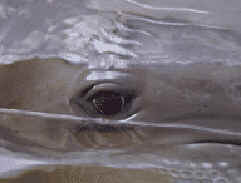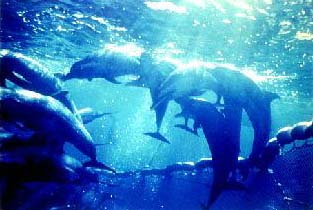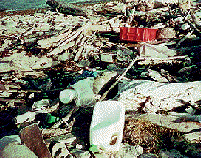 |
 |
 |
 |
 |
 |
 |
 |
 |
 |
 |
 |
 |
 |
 |
 |
 |
 |
 |
 |
 |
 |
 |
 |
 |
 |
 |
 |
 |
 |
 |
 |
 |
 |
 |
 |
 |
 |
 |
 |
 |
 |
 |
 |
 |
 |
 |
 |
 |
 |
 |
 |
 |
 |
 |
 |
 |
 |
 |
 |
 |
|
|
Threats To Dolphins |
|
|
|
"If dolphins could cry for their dead, their oceans would be full of tears."
(Source Unknown) |
|
|
|
There are many threats to dolphins. Besides the natural threats such as disease, stranding and preditation from sharks and killer whales, there is a bigger threat, Man. Man polluts the seas, man over-fishes, man kills the innocent, man rips families apart, man abuses. It is at the hands of man that dolphins suffer and die, yet it is at the hands of man that the dolphin will not suffer and will survive. Because what man has done to destroy, only man can fix. Please help these beautiful animals and their home before it's to late. |
|
|
|
 |
|
|
|
 |
|
|
|
Could you look into this eye and say no? |
|
|
|
 |
|
|
|
Fishing Nets
|
|
|
|
In many parts of the world, an increasing number of cetaceans become entangled and drown in fishing nets every year. The problem varies according to the type of fishing net used, local customs, the species and the fishing season. In some cases, a simple modification of either the nets or the management system can significantly reduce the incidental catch; in others, there may be no alternative but to ban the fishery. Most of the fisheries that kill dolphins do so accidentally, but tuna fishing is a notable exception; many fishermen set their nets around dolphin intentionally, knowing that they tend to swim with tuna, as it is the cheapest and quickest way to catch the most fish. The dolphins then become entangled in the nets, and are not able to reach the surface, so they drown. The dead dolphins are then discarded overboard.
Types of nets that kill dolphins:
1. Drift nets
2. Tuna fishing net
3. Gill nets
|
|
|
|
 |
|
|
|
Dolphins caught in a tuna net |
|
|
|
 |
|
|
|
Slaughter |
|
|
|
Small cetaceans are being hunted, especially in Japan and South America, with nets, rifles and hand-held harpoons. They provide meat for human consumption and bait for crab fisheries.In some areas, where fish stocks are severly depleated because of over-exploitation, these cetaceans are blamed for the scarcity of fish and are "culled" to "protect" the rest of the stock. Conservationists have been campaigning for many years to stop the hunting. |
|
|
|
 |
|
|
|
Stranding |
|
|
|
Every year, thousands of dolphins, whales and porpoises are found stranded, alive and dead, on beaches all over the world. They may be alone or in groups, and while some animals are old or unwell, many of them are young and healthy. This is a natural phenomenon, and has been happening since time immemorial, but it remains one of the great unsolved mysteries of the animal kingdom. |
|
|
|
 |
|
|
|
High and Dry; Pilot whales mass strand on a beach |
|
|
|
Some strandings are easy to explain: The animals simply die at sea and are washed ashore with tides and currents. But live strandings are more mysterious, and many theories have been put foreword to explain their possible cause. One theory is that changes in the earths magnetic field cause the animal to lose it's sense of direction. Alternatively, an earthquake or storm could cause it to panic; brain infection could cause disorientation; it's sonar system may fail; or it might simply get lost or feel unwell and need to rest. In mass strandings (like the one in the photo above), the whole pod may be in trouble some way, or they may be following one individual that is ill or disorientated. |
|
|
|
 |
|
|
|
Pollution |
|
|
|
Pollutents may enter the food chain near it's bottom and build up in top predators, such as cetaceans. In addition, cetaceans may digest the waste and debris from discarded fishing gear. Mineral exploration and expoitation are also a concearn, but unless cetaceans are caught in survey explosions or oil spills, the danger is probably minimal. The effects of such toxins on cetaceans are not entirely clear. The death of cetaceans due to pollution is difficult to recogonize, especially when it occurs in large numbers. In other mammals, polychlorinated biphenayls (PCB's) adversely affect reproduction, and at the same time may hold true for cetaceans. |
|
|
|
 |
|
|
|
A polluted beach |
|
|
|
 |
|
|
|
Captivity |
|
|
|
"No aquarium, no tank in a marineland, however spacious it maybe, can begin to duplicate the conditions of the sea. And no dolphin who inhabits one of these aquariums or marinelands can be considered normal."
(Jacques Cousteau) |
|
|
|
Bottlenose Dolphins, Killer Whales, False Killer Whales, Belugas and Irrawaddy Dolphins are just some of the ceataceans that are caught in the wild to be kept in marine parks and zoos world-wide. Captivity is one of the most physical and emotional abuses dolphins suffer. Dolphins are one of the most family oriented species in the world. Capturing a dolphin from it's family to be put into captivity is very stressful for both that dolphin and it's family. Many dolphins die before they reach their new homes. Some problems that dolphins suffer from in captivity are suciciide, depression, agression between tank mates, ulcers, skin diseases, chlorine and other chemicals in the water (often causing blindness) and refusal to eat.
Many dolphins tend to switch off their sonar because when they let out a sonar which reflects off the walls of the tanks and heads straight back to the dolphin with an increadible force. This often causes ulcers in the head. In the wild, dolphins swim many kilometres every day. In captivity, they are confined to a few metres. Also, dolphins tend to live less then half their age in captivity. In the wild, a dolphin's life span can range between 20 - 80 years. In captivity, they usually only live to about 10 years and are considered old when about 20 years. |
|
|
|
 |
|
 |
|
|
|
|
|
Captive Orca:
Confined to a few metres |
|
|
|
Wild Orca:
Can swim hundreds of kilometres |
|
|
|
|
|
 |
|
|
|
 |
|





